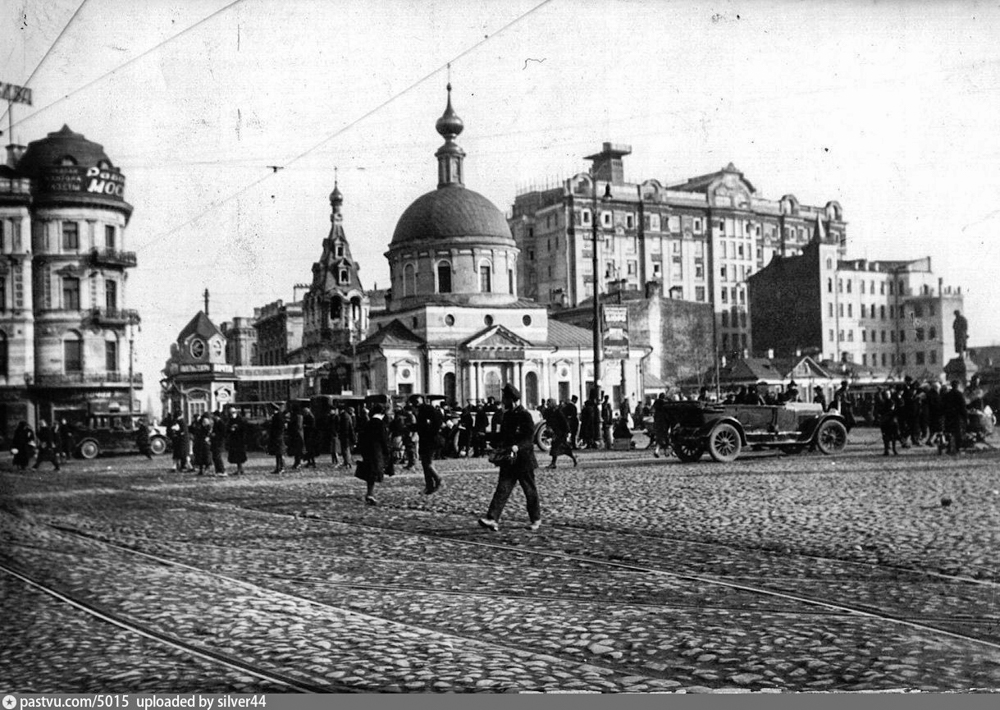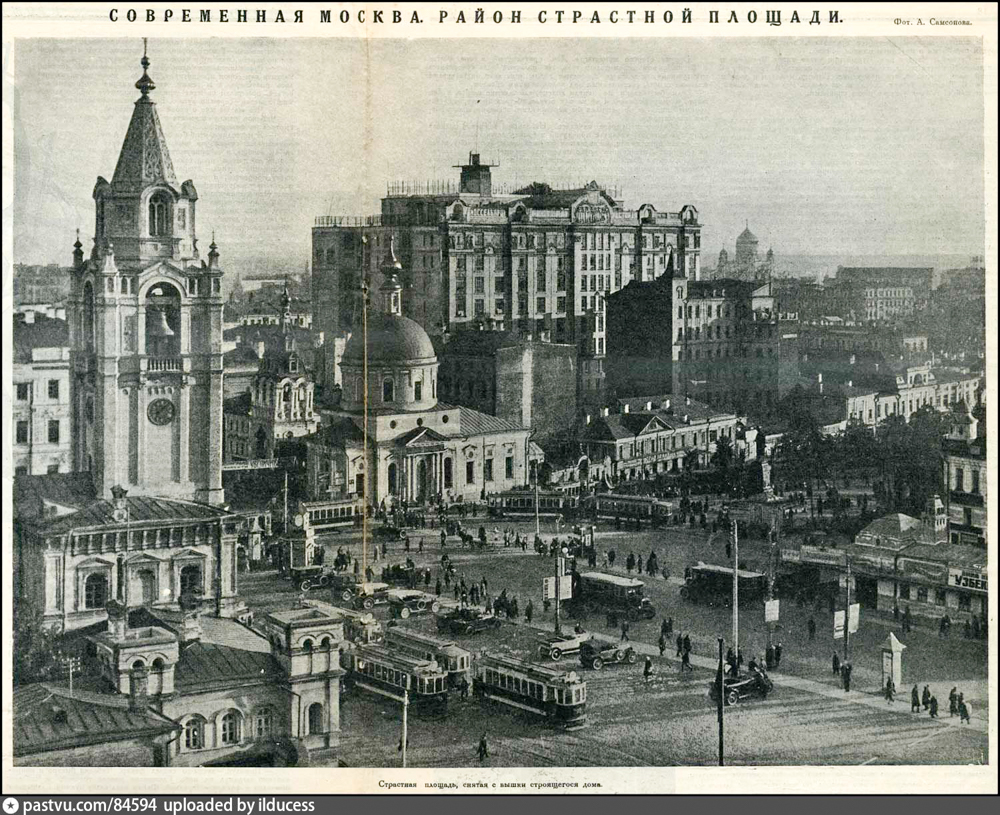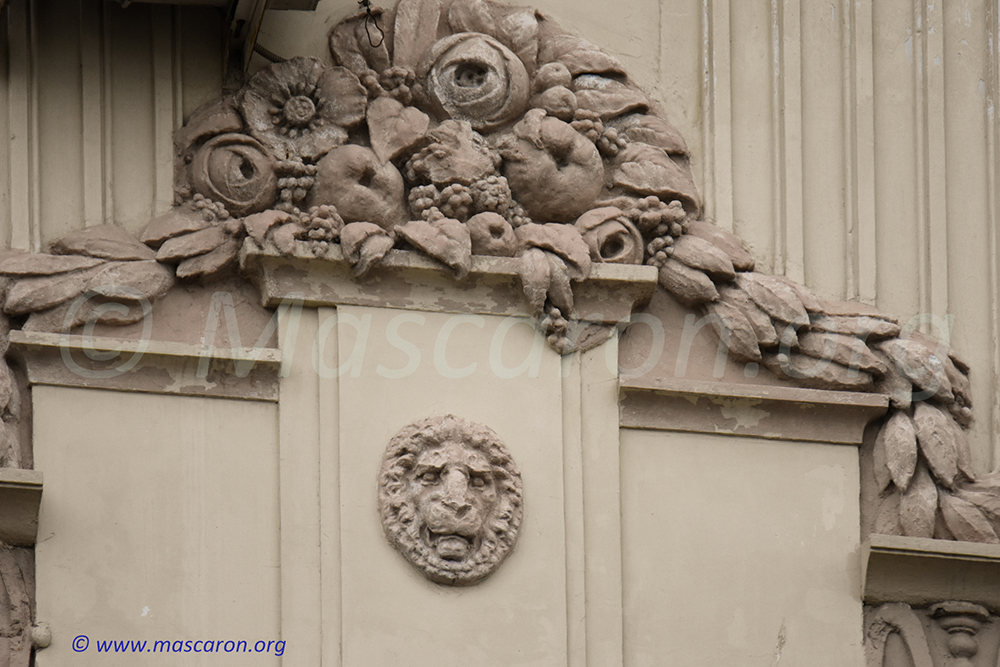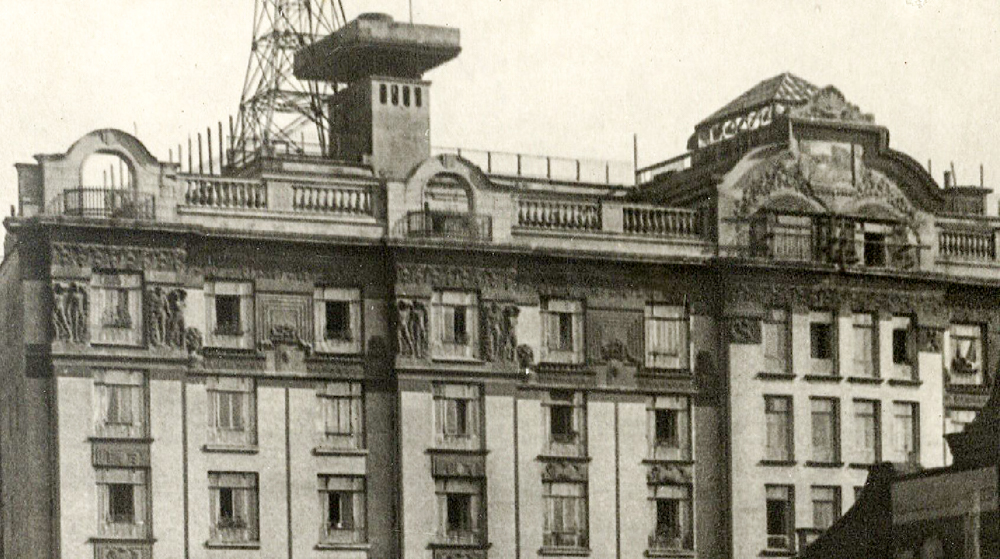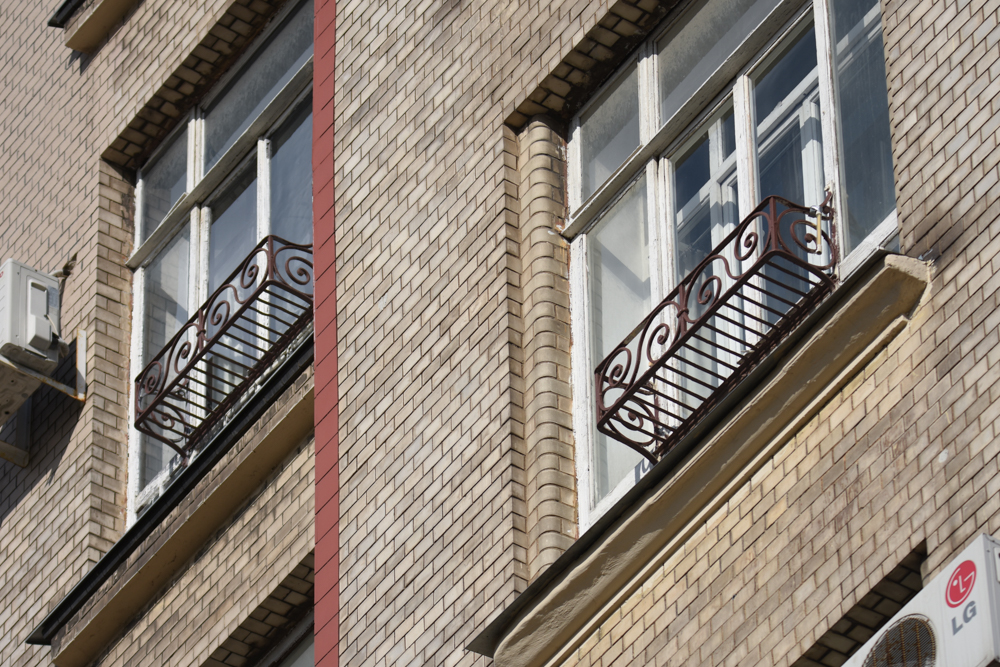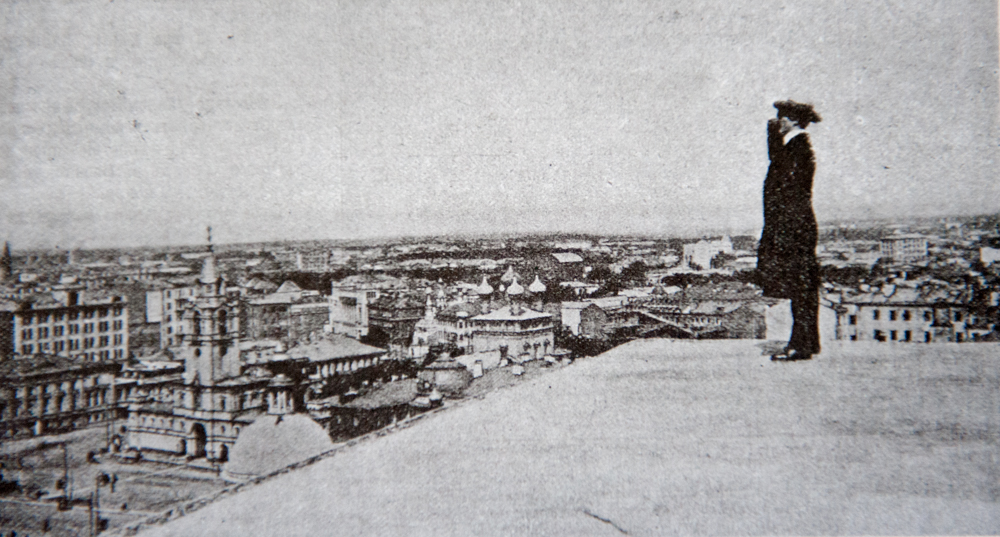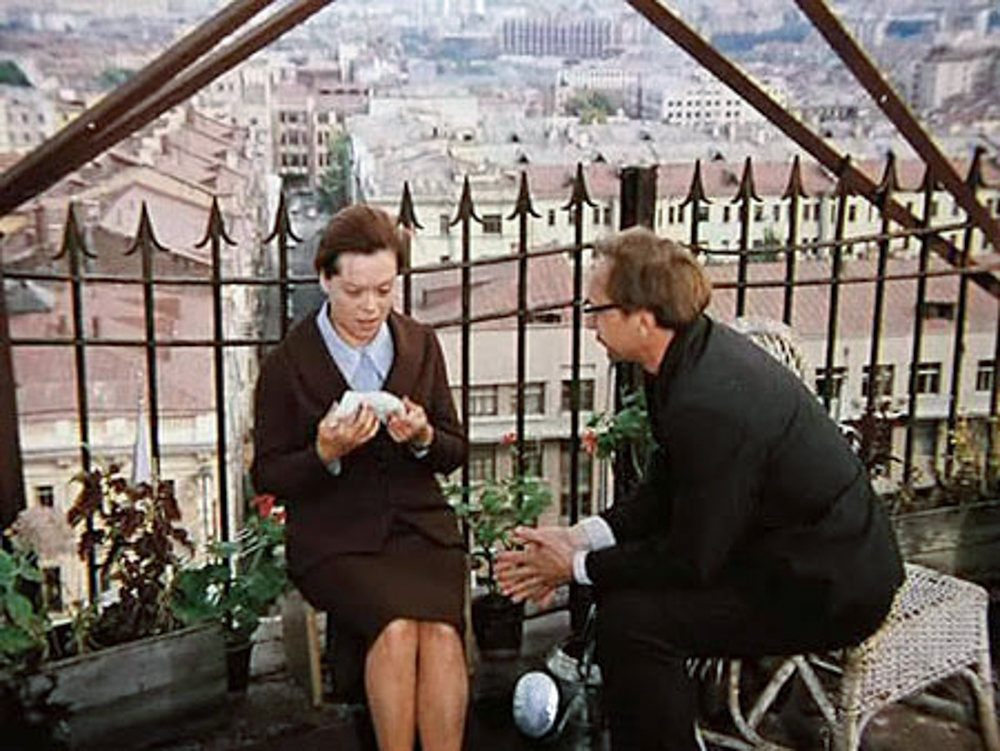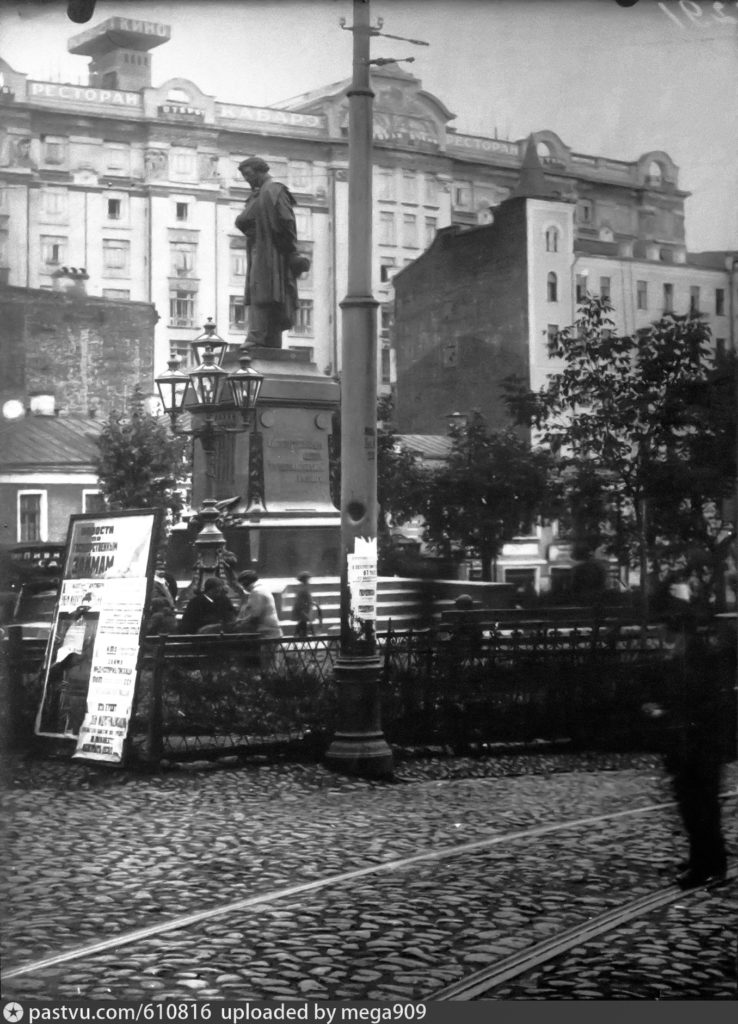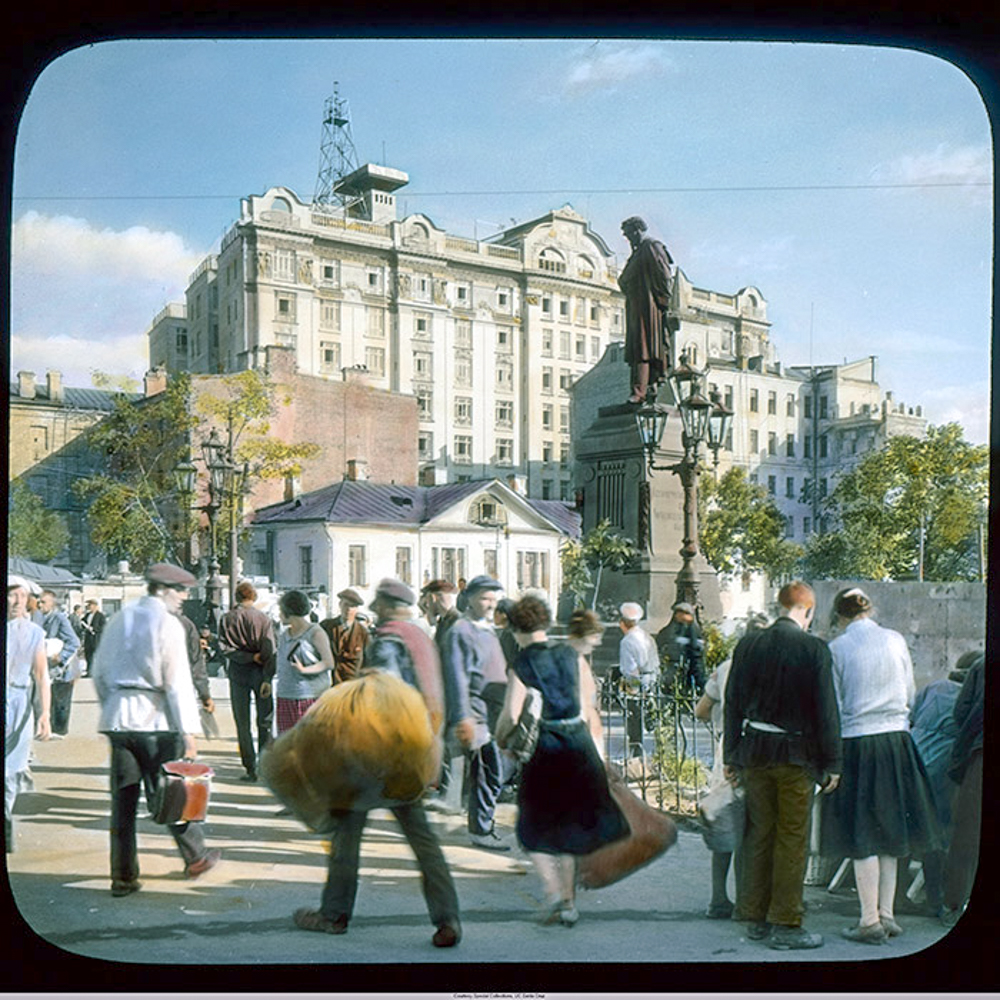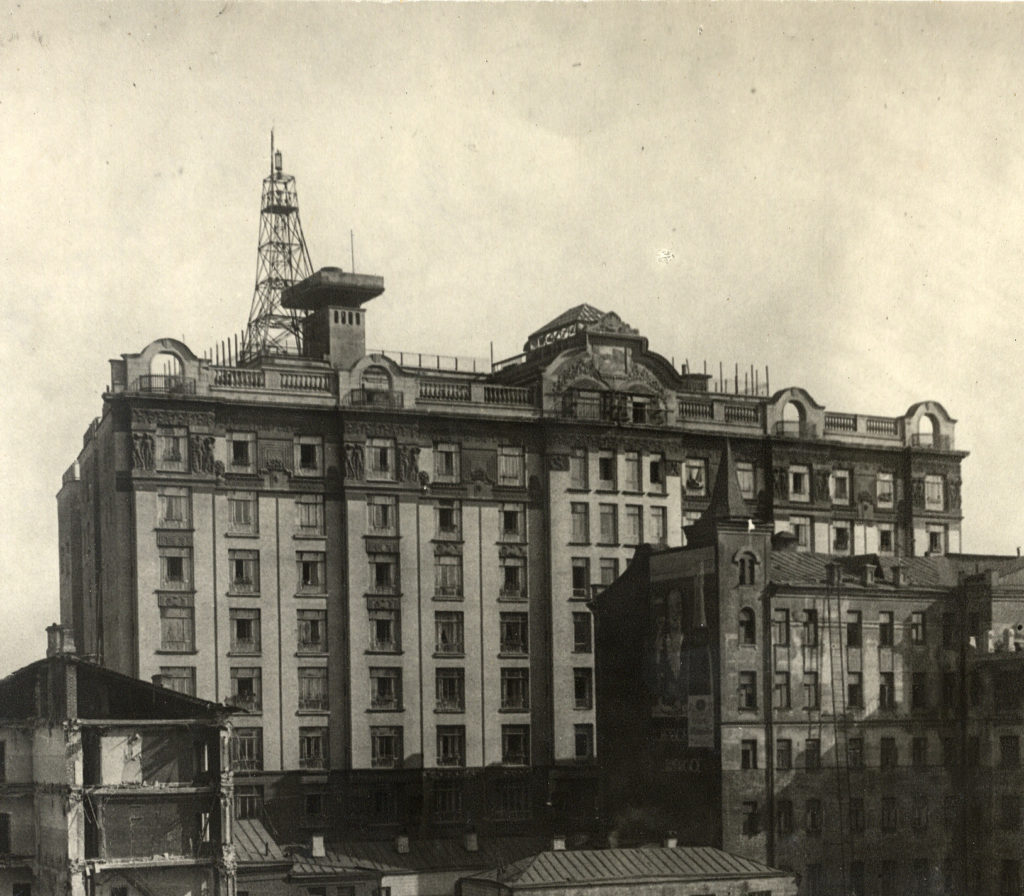Nirnzee House
The Russian word «Neboskryob» (which actually means «skyscraper») has long become so familiar that even thoughts do not arise, that something is scraping the sky. The sky is scraping by simple «Skyscraper», which «literally» (word by word ) translates as «Neboskyiob»: it is combination of two Russian words «Nebesniy”- sky and “Skrebok” scraper !
However, at the very beginning of the 20th century, Moscow adopted a different interpretation, the designation of a new word and for that time the very phenomenon of high-rise construction — «Tucherez» (again it is combination of two words “Tucha” – cloud and “Rezat” – cut. So it could be said, translated like “Cloud cutter” ). Now of course, «tucherez» (cloud-cutter) sounds unusual and amusing, but it is this unusual word that makes you think about what has been built here, and about the peculiarities of high-rise construction..
For the first time, the word «tucherez» sounded and began to come into use in Moscow in 1904-1905, when the 34 year old architect Osip Osipovich Shishkovsky built a profitable house for Fedor Ivanovich Afremov, who earned his fortune in vodka production. The Afremov House on Sadovo-Spasskaya, 19 has 35 meters high, 8 floors, was built in 1904. It became the tallest building in Moscow. Comparing with the first «official» skyscraper, built in 1885 in Chicago for an insurance company (10 floors, 42 meters), the first Moscow «tucherz» did not reach it a little bit. But unlike the Chicago building in Moscow, the steel supporting frame was not used then. This the steel supporting frame in many ways determined the rapid development of «skyscrapering» beyond the ocean.
And the more significant it is that in 1913 the «technician of architecture» (as he signed his projects) Ernst-Richard Karlovich Nirnzee (Niernsee? Here and below will be used Nirnzee) built in “old manner” building, without a load-bearing metal frame. It was more than 40 meters high building in Bolshoy Gnezdnikovsky Lane, 10 . For many years it was this house that began to associate for the Muscovites with the word «tucherez». «Nirnsee House» in 10 floors was at that time the highest house, exceeding the house of Afremona more than 5 meters.
But not only this those «high-altitude» record made » Nirnzee House » so memorable and significant for both history and architecture of Moscow. This building is associated with many legends, real events and stories, the fate of theaters, famous figures of culture and politics. As soon as building No. 10 in Bolshoy Gnezdnikovsky Lane was not called: «Nirnsee House», «Tucherez», and «Skyscraper», and «House of bridegrooms» and «House of cheap flats», and also «Chedomos», and » Rubinstein House».
This plot of land in the Bolshoy Gnezdnikovsky Lane Ernst-Richard Karlovich Nirnzee bought in 1912 from the previous owner — A.I. Bystrovoy. She unsuccessfully tried to build (rebuild) located on this stretch of old low — 1 and 3-story houses. During the work, one of the houses collapsed, workers were killed, and the “benevolent” townspeople began to ascribe to this place various mystical fictions, fables — a “damned” place!
But this “story” did not stop Nirnzee on May 5 (17 on a new style) in 1912 to file a petition to the Moscow city authorities, in which he wrote: «…. I beg you to allow me to break down existing buildings … build a stone 9th-story residential building for small apartments, with Residential semi-basement «. Further in the request, the architect specified: «… with a separate dining room over part of the 9th floor, central water heating, a gateway under the arch.» Permission was received quickly and in the summer of 1913! Year the building was erected under a roof, and internal arrangement has begun. It’s hard not to agree — very quickly!
True, it was not without misfortune again. Even during the construction, a special commission, included engineers, builders and architects was created. The commission insisted on reducing one floor of the almost constructed building. Nirnzee managed to defend his builging — he proved the consistency of his calculations. But then the next “contretemps” happened: on June 28, 1913, during the construction, a fire happed, which did not cause much damage, but caused the arrival of a large number of firefighters detachments, and, accordingly, their discontent. The reporter of the «Voice of Moscow» Vladimir Gilyarovsky, hardly managed to get to the scene. Then he wrote that in case of possible fires due to the narrow alley, firefighters will almost never get to the place of fire.
Soon, the building itself was attributed by other legends, which it is not always possible to verify now. Allegedly immediately after the construction of the building, when the family of the architect himself moved to it, his wife on the stairs turned her leg. For a long time, being restricted in movement due to the stretch, she began to «hear voices». Some tenants immediately «picked up this «contretemps»- they also began to complain that «voices «are heard in the house. They began accusing Nirnzee of some kind of «dark» intents, or even spying for the nearby police guard station, with a usage of installed acoustic instruments. All attempts to explain that he, as a homeowner, has no reason to «frighten» the residents, did not remove from the «righteous» citizens the suspicion of «unclean place», «damage» of home. Already after the outbreak of the First World War, when the mass oppression of the German population began in Moscow, the architect’s son, allegedly addicted to the bottle, died after falling from the roof. On top of everything, the Muscovites began to notice a mysterious glow on the roof of the building (metal fences existed here). Apparently, what the lights of «St. Elm» are knew far from a large part of the population who sacredly and finally believed in the «unclean» place. They say that they would like to invite even «holy» fathers from nearby monastery to «clean» the building, but the kind «holy» fathers refused to «their neighbor» in such a request.
Surrounded by the buildings of the 18th and 19th centuries preserved yet in 1913, Nirnzee’s towering building could not be missed. Against the backdrop of its neighbors, the house looked literally «defiantly», and, undoubtedly, attracted attention, depriving the status of the dominant and the church «Church of Dimitry of Solunsky» standing on the corner of Tverskaya and Boulevard and, in part, the belfry of the Passion Monastery located nearby.
The favorable location greatly facilitated the rapid settlement of the house, which confirmed by the insightfulness of Ernst-Richard Karlovich Nirnzee. Already in their application for construction, Nirnzee’s abilities not only as an architect and builder, but also as an entrepreneur are revealed. He accurately «figured out», as is now customary to say, the target audience — potential tenants, apartment renters. They were successful, quite wealthy (but not yet for luxury multi-room flats of expensive Profitable house) lawyers and doctors, artists and actors, journalists and employees of nearby offices. As a rule, they were energetic and enterprising people who had not yet had time to acquire a family and were not burdened with household concerns. Therefore, almost all the apartments, although, as Nirnzee pointed out in their application — «small» — from 27 to 48 square meters — were well built and designed to accommodate one person, most importantly, these flats were financially accessible to this «middle class» for removal or purchase. That’s why this house got another name — » house of bridegrooms» (“fiancés’s house”) and — «house of cheap apartments».
The architect applied a corridor (hotel) system when more than 30 similar one-room apartments were on the floor, not 2-4 apartments for one entrance — front door, as at that time it was accepted in «rich» profitable houses. And only at the ends of the corridor, which actually united several entrances, provided for 2-3-bedroom apartments for small families.
For all the «small» apartments in exchange for the missing in their separated kitchen facilities Nirnzee envisaged the creation on the roof of the building «separate dining room over part of the 9th floor.» In fact, it was another, full-fledged — the 10th floor of the building, almost a «penthouse», with access to the roof and its own observation deck. In addition. Also «samovar» rooms existed on each floors. Here, in these «samovar» rooms the chambermaid always had a melted samovar – hot water and tea for the tenants. The maids also brought food products and some dishes delivered by special elevator from a dining room (according to the recollections “buffet” worked on the 1st floor) to the apartments of the residents. Nirnzee envisaged a «residential basement» as an additional space where the tenants of the building could receive guests and arrange big «party», celebrate the holidays. In general, it turned out a kind of a new model of social living, which largely outpaced its time. It was this model that was later copied in some houses of the Soviet period, so-called period of constructivism, for example, in the house for workers of the State Insurance (1926) and in the house Narkomfin (1930).
Currently, the » house of bridegrooms » is almost completely hidden behind the facade of the house of 1940 at the corner of Tverskaya and the boulevard, known as the «house under the skirt.» But nevertheless it is still good enough to distinguish (best place — from the boulevard) a small mosaic panel «The Little Mermaid» at the level of the 10th floor.
Framed with stucco ornament panel is the author’s copy of the eponymous panel from the hotel Metropol (on the right side of the facade, to the Theatrical passage) of the painter Alexander Yakovlevich Golovin. There is a legend that Nirnzee, placed in his previous apartment located in his own profitable «house with a starling-house» in Trekhprudny Lane, could consider (in a telescope?) this mosaic in Gnezdnikovsky Lane. If you carefully consider the panel (click the foto), you can see some kind of arc on the tiles in the upper third of the panel. This is due to the fact that the original version of the “Little Mermaid” for the Metropole was not located in a rectangular opening, but in a semi-circular end. Therefore, it can be confidently asserted that the same «forms» were used and the work on making panels for the “Nirnsee House” was carried out, as for the Metropol, at Savva Mamontov’s factory Abramtsevo.
Here is how Golovin recalls his work for the hotel “Metropol”: «Already after his financial collapse, Mamontov continued to manage his ceramic workshop Abramtsevo (for Butyrskaya Zastava). In the workshop of this I worked for a long time, until moving to Petersburg. In it, according to my sketches, a panels for “Metropol” were made».
There are mentions in the “net” that allegedly during the repair of Metropol in 1989, the original Golovin’s ceramics was passed to Finland (?), and a new, modern copies were created for Moscow. So, it is possible that the panel on the House of Nirnee became the actual, real ORIGINAL of Golovin’s work in Moscow.
The Gnezdnikovsky lane itself has a slight bend, but looking at the facade of the “Nirnsee house” it almost does not catch sight. This is what Nirnzee proposed for this optical illusion in his application for construction: «The five projections on the facade are made solely for the purpose, first, to diversify the large plane of the facade and, secondly, to smooth out the fracture of the land in the middle of the property by an average protrusion …» . Now at the level of 8 and 9 floors the masks of lions, located under a rich vegetable molding pattern, and two panels with a male figure are still diversify the façade.
http://mascaron.org/?pid=1976 http://mascaron.org/?pid=1975
But initially between the windows on the 9th floor there were also full-height antique images (as far as can be judged from the photographs of the 1930s) bas-relief images. Such decorative decoration of the facade — the upper floor visually «facilitates» the facade and concentrates attention precisely on the «top» of the house, making it a compositional center.
Today, on some floors on the same facade in Gnezdnikovsk, iron boxes for flowers on the windows designed by Nirnzee could be observed — the architect hoped that the tenants themselves will «enliven» with flowers this dark, squeezed facade of their house in a narrow alleyway. Although in one of the photographs (see below) of the 1930s it can be seen that there were more landscapers then. And that in the apartments facing the narrow Bolshoy Gnezdnikovsky Lane, there was still more light, many windows designed by architects are tall ones, starting almost from the floor.
Apparently, not all hopes of the architect for the residents of the house are fully realized in our time. Unfortunately it was not possible to detect the «memories» regarding the greening of the facade by those prerevolutionary inhabitants of the house.
But there were many memories of the now famous Roof of the “Nirnsee home”! First of all, back in May 1913, the architect himself in an interview for the “Moscow leaf” said: «Do you believe, I still can not look at the sight of Moscow from here … Yes that I … Even my bricklayers on holidays are climbing up here, and Idle in silent contemplation for hours. » Almost before the beginning of the 30’s, the roof of the “Nirnsee house” was almost the highest, and from it a panoramic view of the whole city.
Until now, it is not possible to accurately identify this gentleman on the roof. On the one hand, the headdress, characteristic for car enthusiasts of the time, can point to Nirnzee, who was the brow of the Moscow Automotive Society, besides on the roof there is still no fencing, and hardly an outsider could be there during the construction. On the other hand, the character does not match the description of Nirnzee, which was preserved in the archives of the Moscow secret police: he was under suspicion in 1905, allegedly having some relation to the organization of meetings at home.
In the summer of 1915, the «Association of V. Wengerov and V. Gardin», which became known as the «Kinochayka» (not without the Seagull (chayka) of the Art Theater!) had equipped winter film pavilion on the roof of the Nirnzee house. This roof from the very beginning caused an unkind attitude to itself from the Moscow firefighters. But the architect designed a flat roof as «inhabited» from very beginning. Even special lead thin sheets were made, which for a long time (was replaced by a tar coating at the beginning of the war in 1941-1942) provided reliable insulation. One way or another, but the «Partnership» was able to agree with the firefighters, promising to comply with their demand, do not to invite more than 100 people in the pavilion simultaneously. In addition to filming in the pavilion on the roof, a school for filmmakers was planned, including acting and cameramen, directing (production) and make-up classes.
Vladimir Rostislavovich Gardin, who by that time had experience as a theater actor, and directing experience in the cinema, it was not difficult to invite to the new pavilion the actors from the nearby Art Theater, Tairov’s Theater and the cabaret-theater located in the house. On the roof, Gardin made several films. Preserved memories that during the filming of one of the stunts specially invited circus actror Bek-Nazarov (Amo Bek) almost died. Down pipe, by which he began to descend, suddenly departed from the wall, but the stuntman miraculously, clinging to small brackets, managed to descend down. To the common disappointment, the image, due to technical problems with the movie camera, was bifurcated, and the film was rejected. Bek-Nazarov was paid a fee, at that time essential — 500 rubles. The episode was not reshuffled: no one agreed to repeat this trick. Moreover the budget of «Kinochayka» was no longer allowed to do that — it was a 10-episode film, and each series had a strict budget, calculated from the income of the previous series. That’s how Bek-Nazarov remembered this trick. By the way, he became a well-known Armenian (Soviet) director later, Ambartsum Ivanovich Bek-Nazarov. «But, somewhere on the seventh floor level, the tube jumped out of the grooves and swung freely in the air. I was petrified with horror. The crowd gathered below also froze, realizing that perhaps the last seconds of my life had come …. I had nothing to lose, and I decided to overcome the dangerous space, holding not the pipe, but the brackets for which it was attached. But the brackets were crammed into the wall almost to the ground: for their free part you could grasp only three fingers. In addition, for a while I had to hang on one hand, and the other to blindly look for the next bracket. But everything worked out, My trained fingers did not disappoint me. When I came down on the ground, barely standing on the ground, the crowd looked at me as if I really was a felon of hell …. «Many years later, in 1966, the film studio «Armenfilm» was given the name of A. Bek-Nazaryan.
The views of the founders of the partnership, on the one hand, the entrepreneur (Wengerov), and on the other hand — the «man of art» (Gardina) began to diverge. Gardin left the Association, and in May 1916 Kinchayka in the Pavilion on the Roof was replaced by the «Coffee-Roof», about which a little lower.
The «cinema» tradition was continued in 1924, when the «Association of Revolutionary Cinematography» (ARC) was established in “Nirnsee house”. This association was formed on the initiative of writers and filmmakers, among whom were S. Eisenstein, V. Pudovkin, L. Kuleshov Y. Kulikov, V. Erofeev. But even the slogan of the association «Cinema at the service of the country of the Soviets» did not save it from the dissolution in 1935 at the 1st All-Union Conference of Creative Cinematographers.
However, the roof of the Nirnzee House continue to attract to itself the filmmakers and later. On the Roof, scenes from such well-known movies as «Office Romance» (Eldar Ryazanov, 1977), «Fairy tales … tales … tales of the old Arbat» (Savva Kulish, 1982) were filmed. And in the house shot small episodes in the movies «The meeting place can not be changed» (Stanislav Govorukhin, 1979), «Courier» (Karen Shakhnazarov, 1977) were filmed also. And already on the roof itself in the middle of the 20-ies and later in the 30-40’s worked a “cinema” for the residents of the house.
In 1916, after Kinochayka had actually left the Roof, instead of the «cinema» pavilion, cafe «Roof» with the «Theater of Miniatures with Music» was housed In the once-planned Nirnzee «separate dining room over part of the 9th floor». May 1916, the Moscow businessman Alexander Sergeyev opens the “Roof”, as he indicated in the accompanying documents «Coffee-roof.» In the journal “Scene and Arena”, on July 24, 1916, a report about the opening of the institution was published: «On the roof of the Nirnzee skyscraper (although the house already belonged to Dmitry Rubinshtein — note mascara.org), a café was opened in Bolshoy Gnezdnikovsky Lane, the first day of its existence was devoted to charity. The whole income is in favor of labor assistance to war invalids. The novelty of impressions, its New York in Moscow, attracted a lot of people, where, under the open awning on stage, the audience attended a concert program, consisting of brilliant names … ..Blue-lilac evening vastness of Moscow, embroidered with beads of lights, separate silhouettes of tall buildings, the bells that loomed on the amber sunset background, the freshness of the evening wind, the height of the fenced from the dust, the bright lights of the cafe and the grandeur of the roof, not at all like the concept of a «roof» unlike, but rather, resembling the building of a resorts hall in some of the most recent western resorts … The view from the roof is really grandiose and magnificent …. «.
Sergeyev planned also the opening of a «theater of miniatures with music», but the «administrative resource» intervened — at the request of the Moscow authorities again because of fire safety requirements already in September 1916, the «Coffee-Roof» was closed. And a year later, on the roof of the “Ninrzee house”, there were cadets who tried to resist the supporters of the October Coup of 1917. Strategic height did not help .
But the Roof did not «give up,» and in 1921 the reopening of the «Roof» cafe was held. This was the time of the beginning of the NEP (new economic policy), and the entrepreneur Zharov (?), taking advantage of this opportunity, planned to accompany his institution to a cabaret again. Here is what the magazine «Theater Moscow» wrote in 1921: Daily strolling over Moscow Garden. Roof. Bolshoy Gnezdnikovsky, 10, former. Nirnzee. Daily strolling over Moscow. Cinema in the open air. Cafe-restaurant under the direction of Zharova. In the covered pavilion from 12 o’clock in the evening — a cabaret with the participation of the artists of the Small and Chamber theaters. In case of dirty weather, play in the buried pavilion. The garden is open from 6 pm until 3 am. «.
This is a photograph of 1921-1924. It is possible to read on the parapet of 10 floors the advertising — Restaurant, Cabaret, Cinema. On the Roof, among the tubs with small bushes and trees, other flowers that together formed a kind of garden, tables were laid, the orchestra played, and again earned an observation deck.
In 1924-1925, with the end of the NEP, the Cafe-Restaurant was gradually changing. At first it became the dining room of the Mosselprom, but, a little later, the «Cafe-dining room «Roof «, which, like the restaurant «Prague» in Arbat street, was managed by the Mosselprom. The place was still attractive, as the press wrote: «The only place in the summer for recreation, where in the center of the city is given the opportunity to breathe the mountain air and enjoy the wide open horizon — an unforgettable view of Moscow from a bird’s flight — on the Roof. Rise on the elevators from 5 pm continuously. Entrance fee on the Roof with the right of lifting 20 kopecks. The orchestra is from 9 pm. In a closed hall and in the open air — a movie. »
But the well-known events of the second half of the 30s and the settlement on the 7th floor of comrade Vyshinsky, the architect’s idea of a «separate dining room over part of the 9th floor» could not bear. The roof ceased to feed both residents and guests, and began to live another, no less meaningful life.
In fact, the roof of “Nirnsee house” replaced café by yard for children and their parents living in the house. As such, there wasn’t any yard near the building, and all the free time, the usual, regular children’s household «life” was on the roof. In summer, on the roof (and along the long corridors of the house itself), they rode bicycles and scooters. While designing the building, Nirnzee envisaged the creation of a site for roller-skating on the roof. He was not the first to suggest such kind of a flat roof usage: four years earlier Fedor Shekhtel had built a skate-ring on roof of his mansion on Bolshaya Sadovaya Street, where Mayakovsky, already familiar with his family, Vera, the daughter of Fyodor Shekhtel, was entertaining on rollers. But Nirnzee was the first to implement such a project for skating on the roof of a high-rise building and for a much larger area. There is information in one of the publications about the iron bridge that connected the two wings of the House, which created a kind of circular track. But in most memories of such an iron bridge on the roof is not mentioned about.
In winter, the skating rink was flooded on the roof, old-timers remember that there was a snow thrower and janitor took care, cleaned, the skating-rink. In the summer, the roof was planted with trees — as before, a box of flowers were placed, and even lilacs were planted in tubs. The club was equipped, and the cinema screenings were resumed. As in an ordinary yard, Roof saw how they beat out carpets and dried clothes. Several kindergartens had been gradually formed In the building in Gnezdnikovsky. There was even one private for 5-6 people — it was difficult to place more children in a small apartment. Walks were made both on Tverskoy Boulevard and on the Roof, where a sandpit was equipped. Older children played with the ball, which sometimes flew through the fences. Lifters refused to carry «messengers» — had to run and look for the ball flew away.
On the Roof, yard «football championships» were arranged! Konstantin Yesenin, the son of Sergei Yesenin and his second wife Zinaida Raich, later Meyerhold’s wife, remembered (Konstantin Yesenin himself lived nearby — in Bryusov Lane, not so far from “cloud-cutter”) : «… I especially liked to play on the roof of a ten-story building in Bolshoy Gnezdnikovsky Lane. It was the tallest building in Moscow. Once in the days of NEP there was a «roof-garden»: something like a restaurant with a variety show. At the beginning of the thirties on this very roof football reigned. It was a great, great, great, as now sometimes they say, football. There were no regulated and administrated championships of schools, lanes, yards. I still remember the central match of that season, the season of 1932 … I remember that I sacrificed for him some very important game on «Dinamo». Still would — the team of Bryusovsky lane played with the «masters of the field» — Gnezdnikovsky lane».
Already from the very beginning of the war in 1941 an anti-aircraft battery was places on the roof, and a bit later — an outfit for salutes. The building was lucky — despite the fact that it was still one of the tallest buildings, the “Nirnsee house” was not damaged during the bombings, and its roof for a long time (until the 80’s) served as a base for the geodetic tower — the photos are good to see it. This main triangulation sign was set down for all geodetic work in Moscow.
As for the «separate dining room over the part of the 9th floor», then there were also dramatic changes: the menu offered only one treat — «spiritual food.» Since the mid 30-ies in this facility the publishing house «Soviet Writer» (“Sovetskii pisatel”) housed in. Marshak, Paustovsky, Kataev, Olesha Simonov, and Tvardovsky became regulars of the «pigeon house», as this 10th floor on the roof was nicknamed by this “writers club”. Pasternak often visited here, he published several of his books in the publishing house “Sovetskii pisatel”. After the journals Znamya and Novy Mir in September 1957 in refused to publish the novel “Doctor Zhivago”, Goslitizdat in January 1958, trying to prevent the publication of the novel abroad, concludes a contract with Pasternak for the publication of the book. In some sources it is mentioned that the manuscript (one of the copy) of «Doctor Zhivago» was for some time under this «roof» of the publishing house of the «Soviet writer». But the actual inaction of domestic publishers did not stop the author of the choice: the first edition of «Doctor Zhivago» was held in November 1958, yet in Italian in Milan in the publishing house Feltrinelli.
In 1974, when the «Soviet writer» moved to Povarskaya 11, the editorial office of the magazine «Questions of Literature», which simply called «Vopli» (it is something like abbreviation “Voprosy Literatury” (Questions of Literature) . Another meaning of Russian word VOPLI is wailing), occupied the premise on the Roof. There are also mentions of other editorial offices that have placed in the “Nirnsee House” at various times: publishing houses “Gudok”, “Evening News”, magazines “Rossiya”, “Litucheba”, “Ogonyok”, “Almanac of the Bibliophile”.
Not only the Roof, but also the “Nirnsee House” itself is inextricably linked with Russian literature and art. The Moscow office of the newspaper «Nakanune» (“On the eve”) published in Berlin was placed on the first floor from 1921 to 1924 here. The newspaper, which continued the «ideological line» of the compilation “Smena vekh” (”Change of Milestones») which was published earlier in Prague (1921) and the eponymous magazine published in Paris (1921-1922), was aimed at returning the first wave of immigration. Many well-known writers often visited the Moscow office of «Nakanune». S. Yesenin, M. Bulgakov, K. Fedin, O. Mandelstam, M. Zoshchenko, V. Kataev often collaborated with the newspaper. It is noteworthy that it was in this publishing house, Bulgakov (as, indeed, many others), had the possibility of publishing his journalistic essays, which Soviet censorship had not already missed. His extraordinary talent marked, it would seem, such an antipode as Alexei Tolstoy, who headed the literary appendix of the publishing house » Nakanune «, he called the Muscovites: «Send more Bulgakov».
The editorial office of the magazine «Sine-Fono», dedicated to «cinematography, talking cars and photography» worked In the House of Ninrzee also for some time (until 1918) This was the first edition in Russia, founded as far back as 1907, and dedicated solely to cinematography.
The «residential semi-basement» conceived by Nirnzee for the tenants of his house had equally such rich stories and memorials as the Roof. At the beginning of 1915, the theater studio-cabaret «The Bat» moved from the Milyutinsky lane to this facility, presumably appropriately refitted. Cabaret, or as it was called — the theater of miniatures, arose from comic performances studio (as they say, skits) of the actors of the Moscow Art Theater. At first, they were «closed» to the general public, only for «their» representation. The leadership was undertaken by Nikita Baliev, and the main sponsor of this project was Nikolai Tarasov, a wealthy young man who received a rich «oil» inheritance from his father. By the time of moving to the “Ninrzee House”, the main patron of the «The Bat» Nikolai Tarasov, it was not nearly 5 years: a tragic love «polygon» happened, and Tarasov shot himself. Cabaret «The Bat» functioned as an regular theater, giving commercial performances to the public. The tickets were expensive, but in the new hall there was a well equipped stage, the hall itself could hold 350 people, and a buffet with expensive wines was served.
The decoration of the hall was done by the painter S Sudeikin. «The Bat» at that time was a «landmark» place for the theatrical and artistic life of Moscow, and newspapers, highlighting the first performances in the new hall, noted Maxim Gorky among the visitors. Sir Robert Bruce Lockhart in his book «My Europe» London, 1952 recalls: «During the last two weeks of January 1915, I read» War and Peace «in Russian. Sometimes I went to a ballet or to a circus with Valpol. I was with Guto, when I first met Gorky in the «The Bat» by Nikita Baliev. These days «The Bat» was a favorite place of literary and artistic Moscow. THe performances did not begin until the end of the theatrical performances, and many artists and entertainers appeared there to have dinner, as well as to watch the performance. At the beginning of its existence the Bat was a kind of club of the Moscow Art Theater, and Baliyev himself was a member of the Troupe, but turned out to be an artist not at the height of this strict school. »
At the beginning of 1922, the theater’s premise in Gnezdnikovsky Lane was occupied by the cabaret (theater of miniatures), «The Curve of Jimmy», in which some of the artists, still remaining in Moscow, of the «The Bat» began to work. But already on October 1, 1924, in this «residential semi-basement», as Nirnzee conceived it, performance «Moscow from the point of view» opened the «Satire Theater» begins to exist till now Later, at different times, the theater — experimental studio of the “Maly Theater”, based on the graduates of the school of 1932 — the drama theater under the direction of F. N. Kaverin, and the Gypsy theater «Romain» (since 1931?), Which was once run by M. M. Yanshin. Educational theater GITIS.is located today in the hall in Gnezdnikovsky Lane.
In addition to various theaters, publishers and film studios, the “Nirnsee House” is unique and due its residents and guests who have had a huge impact on Russian art.
In 1914 one of the first lodger in “Nirnzee House” was Alexander Yakovlevich Tairov, whose “Chamber Theater” was located very close, on the opposite side of the boulevard — Tverskoy Boulevard, 23 (now it is the “Moscow Pushkin Drama Theater”). Alisa Koonen (later Tairova’s wife) warmly remembered about this apartment in Gnezdnikovsky: «Friends of Tairov and I loved this apartment very much, we often gathered here for tea …» But already in 1918 Tairov had to leave everyone so beloved apartment, which was arranged and designed by Alexandra Exter – painter (theater, cinema) and designer, a representative of the Russian avant-garde, in many ways she also formed the Moscow direction of «Art Deco.» In 1918, the “Nirnzee House” was chosen by «comrades» from another, mainly, Moscow direction — «Mossovetovsky». These and other new «comrades» from various «People’s Commissariats» then did not stand on ceremony (now they have to invent different laws on innovation), and with enthusiasm they began to replace the old «bourgeois» atmosphere of the building by themselves. So Tairov, in spite of everything after all, was forced to leave his apartment, had to «compact» the house of the family of actress Alice Koenen.
Another lodger of the “Nirnzee House” in 1915 (1914?) was David Burlyuk — one of the founders of the futurism and avant-garde. Vladimir Mayakovsky was very close with David. Here is how he recalls: «I always think with love about Burlyuk. A fine friend. My real teacher. Burliuk made me a poet. » Mayakovsky himself often visited the “cloud-cutter”, and even for some time in 1915 he lived in the apartment of his mother’s acquaintance, who had small art studio here. David Burliuk strongly supported beginning writers, painters and artists — his acquaintances, and there were many of them. He organized for them concert tours around Russia, for what his friends began to call him «Diaghilev of the Russian Avant-garde». In 1918, after a new tour, he was appeared in … Japan, and then, in 1922, moved to the United States. When he visited the USSR in 1956 and discussed the issue of paying for his visit here, Lilya Brik said: «No thousand can pay David those «halfs a ruble» that he gave to the beggar so that he could write poetry without starving.»
Most likely, David Burliuk met in the “Nirnzee House” and with his friends, like-minded artists of united artists «Donkey’s Tail» society, which separated in 1912 from the Society of Artists «Jack of Diamonds».
“Nirnzee House” is connected with «Knave of Diamonds» by another story. In the mid-1940s, after the end of the War, with the participation of the pilot, the participant of the first non-stop flight Moscow-North Pole-San Justino, Andrei Borisovich Yumashev Robert Rafailovich Falk received the studio in the “Nirnzee House”. Falk was back in 1911, one of the founders of the association of artists «Jack of Diamonds.» Evgeni Borisovich Pasternak, the eldest son of Boris Pasternak and the painter Eugenia Vladimirovna Lurie, the first wife of the writer, recalls: «We had drawing evenings at home, hired a model, various people came to paint. This was the beginning of an acquaintance with the pilot and hero of long flights Andrei Borisovich Yumashev, who soon after the war rented a workshop (studio) in Nirnzee house in Bolshoy Gnezdnikovsky Lane, in fact, for Robert Rafailovich Falk, whom idolized. There occasionally he wrote himself, there began to come Mom, who was friends with Falk since his apprenticeship in his class in Vhutemas. Then Falk made mother’s portrait in gray watercolor, and from the high window of the workshop my mother painted a landscape with roofs of houses along Tverskoy Boulevard. » Falk met Yumashev back in Paris (1936), where the artist lived almost 10 years, and a year later, during their joint «artistic» travel across the Crimea and Central Asia, they often wrote together paysages.
Nirnzee House knew and other examples of «artistic» settlement. So the artist and photographer Alexander Rodchenko, represented, including by Western «curators» of galleries and expositions almost the only «instance» of the whole trend, did not hesitate immediately after the October Revolution of 1917 a kind of «revolutionary» initiative. With the support of the Moscow City Council (who quickly got «power» into his own hands) and the new commandant of the House, he moved into one of the apartments of the «former» who hastily left Moscow. Perhaps not without advice from Rodchenko, who agated to follow his example and other artists, Vasily Kandinsky for some time also lived in the “cloud-cutter”.
“Nirnzee House” has a relationship (only indirect?) to the «Master and Margarita» novel by Bulgakov aslo. It was in this building that Mikhail Afanasievich met with Elena Sergeevna Shilovskaya (nee Nyurenberg), who became his third wife. All the researchers of the master’s work agree that she served as a prototype, inspired the writer when creating the image of Margarita. One way or another, but it was in the “cloud-cutter”, on February 28, 1929, that Bulgakov and Shilovskaya met on pancakes (“maslenaia”, as was customary at that time) at their common acquaintances, Moiseyenko’s spouses. A lot of memories of all participants of this meeting have survived: Bulkagov himself and his wife (the second) Lyubov Evgenievna Belozerskaya, with whom he came to Moiseenko for pancakes, and Elena Sergeevna Shilovskaya and her then husband . All these memories are remarkable in themselves, and their various nuances, noticed by the authors, reveal the depth of the characters and give the opportunity to experience the dramatic nature of this and the subsequent events. Officially, the marriage of Mikhail Afanasievich and Elena Sergeevna took place in 1932 only. In the archives preserved Bulgakov”s written note from October 4, 1932 to the director V.G. Sakhnovsky at a meeting of the artistic council: «Secret. Urgently. At 3 3/4 afternoon I get married in the Registry. Let me go in 10 minutes». It is noteworthy that Elena Sergeevna officially terminated her previous marriage only on the eve — October 3, 1932.
Bulgakov several times described the “Nirnzee House” in his works: in the essay «Forty-Forty», in the story «Dvoliaada.» He certainly visited more than once on the Roof, at the theater, and on different floors, where he published a lot in the publishing house » Nakanune » and in the newspaper «Gudok». But his attitude to the House was then far controversial: as Elena Sergeevna writes in one of her seemingly late memories of their first meeting, «… Bulgakov, who somehow decided that he would not be walk in this house «.
Perhaps this was due to the beginning of the next «changes» in the “Nirnzee House”, which could not but affect the «atmosphere», which Bulgakov certainly felt.
“Nirnsee House” knew in his lifetime several owners. The first owner of the House was the architect and homeowner Ernst-Richard Karlovich Nirnzee. But already in 1915, after the outbreak of the First World War, German pogroms, and obvious oppression of the Germans in Russia and Moscow began. Ernst-Richard Karlovich, who came from German family and arrived to Moscow from Poland, expecting nothing good, began to squeeze out the apartment houses that belonged to him. August 11, 1915 » House of bridegrooms» was successfully sold to Dmitry Leonovich Rubinstein for 2 million 100 thousand rubles. Rubinstein, a Petersburg banker, for some time was in close relationship with Rasputin. There were even speculations, that do not find documentary evidence that, allegedly, the banker lost to House Rasputin, who became his new actual owner. The report of the Moscow secret police on March 28, 1915, about the stay of Rasputin («Dark» — such was his nickname in the secret police!) had visited in the house in Gnezdnikovsky Lane, but it was not more than 20 minutes stay. Apparently after that, in Moscow, there were rumors that allegedly Rasputin personally removed the «curse» from this place! But, anyway, right up to the October events and even a lot after them behind the house in Gnezdnikovsky Lane the name «Nirnsee House”
After the October Coup of 1917, the building was nationalized and the Mossovet became its formal owner, and it began to settle new tenants based on «revolutionary expediency». The old tenants, someone «voluntarily», having felt something wrong, left both the house and Russia, and someone, like the above-mentioned director Tairov, released their “square meters” according to the «mandate». Already in 1918, the building was given a new name: the Fourth House of the Moscow City Council, abbreviated to Chedomos. In addition to the various members of the committees, commissions and the “Moscow Council” itself, many employees of new newspapers, doctors, teachers, various directors and other leading comrades registered in the building. Someone lingered in the House long enough, for example, the General Manager of the AMO plant (later ZIS / ZIL), Ivan Alekseevich Likhachev, and someone literally for several months, for example, Vadim Podbelsky, the post and telegraph commissioner of Moscow.
Gradually by the end of the 20s a new image and inhabitants of the house, and its peculiar atmosphere. The “house committee” worked, and even with the inhabitant of apartment № 716 Andrey Januarievich Vyshinsky everybody simply greeted, and together went in the elevator. According to the recollections of the old-timers, then he communicated a lot with his neighbors, differed little from other party figures. Curious fact from the biography of Andrei Yanurievich: after the February events of 1917, he was appointed Commissioner of the Militia of the Yakimanskiy district of Moscow. In fulfillment of the order of his leadership, the new Minister of Justice of the Provisional Government, P.N. Malyantovich, Vyshinsky issued his own «order for the strict execution of the Provisional Government’s order on search for, arrest and trial, as a German spy, Lenin.» Like this! What is called, «think for yourself, decide for yourself.»
And in 1920, Vyshinsky once again changed his party «orientation» — he became a member of the RCP (b) from the Menshevik, and was appointed dean of the Department of Economics at the Plekhanov Institute of National Economy. In the 20’s, he settled in Chedomos, speaking, in addition to teaching, as a prosecutor in various processes. In 1929 he headed still «only» the General Directorate of Vocational Education (Glavprofobr).
In the late 20s, the next change in the Tucherez began. Vyshinsky is already the prosecutor of the RSFSR (then the USSR), the chief State Prosecutor, permanent guard, and a personal elevator. And in Chedomos itself appeared a «spirit» of isolation and suspicion, the house inhabitants began to communicate less with each other, not to mention communication in the State Prosecutor, for known reasons tenants began to change (replaced) frequently. The inhabitants of the “Chedomos” that was formed at the beginning of the 1930s was renewed by at least a third, and a new «loyal» generation of lawyers and other proven «employees» was settled. It became clear to form some kind of stratification already among all this party «anthill»: the 7th floor where Vyshinsky lived, became the yardstick of the «elitism» of the residents of the House. How little has changed since then, except that instead of floor’s numbers now «they» are yardsticked by «settlements» names, who is closer to …
Since that time, it’s been quite years, and to objectively evaluate what is happening now in the “Nirnzee House” it will take some more time. It is a pity that now it is almost impossible not to consider this wonderful building, but simply to notice it among the new environment. But in any case, the building itself, despite its wooden ceilings, as it does — the Siberian larch !, continues to regularly serve in Moscow.
It is a pity that the ancient figures disappeared on the facade of the 9th floor, it’s a pity that the panel «The Little Mermaid» is so mercilessly dirty with the next cosmetic repairs, it’s a pity that you can not play football on the Roof…
And even more sad is the fact that until now it has not been possible to clarify the fate of the truly outstanding architect, who has done so much for Moscow Ernst-Richard Karlovich Nirnzee …
In the US lived the architect Niernsee too,! But his name was John Rudolph Niernsee, and he lived in the 19th century: 1814-1885. He emigrated from Vienna in the middle of the 19th century. Our architect Nirnsee and his brother came to Moscow from Poland at the very end of the 19th century, presumably in 1898. Curiously, could they be somehow related with those Viennese Niernsee?
The personality of Ernst-Richard Karlovich Nirnsee is shrouded in many mysteries: the exact date of his birth is not known, no any of his photographs (authentically confirmed) has not been found till now. In the archives documents were found about his completion of the Moscow construction courses, headed by M.K. Priorov, in 1900, which made it possible to conduct own practice, and start building constructing in Moscow. Since 1901, Nirnsee has designed more than 40 buildings for Moscow! But the fate of the architect himself after 1918 is still simply unknown!
But the house still bears his name – “Ninrzee House”!
PS. In the post was used the book «House Nirnsee», Vladimir Bessonov, Rashit Yangirov. Moscow, 2012
